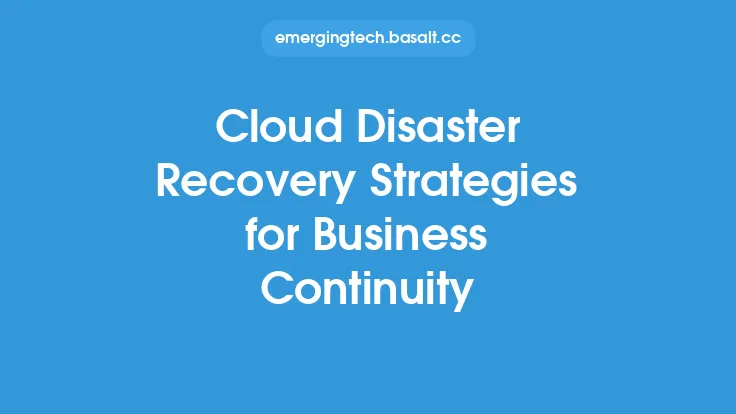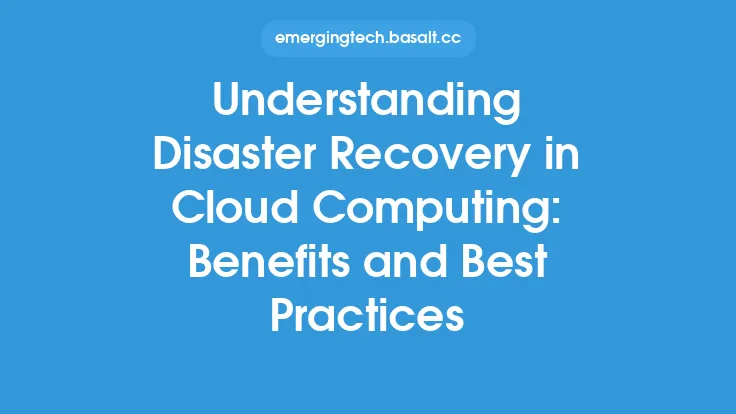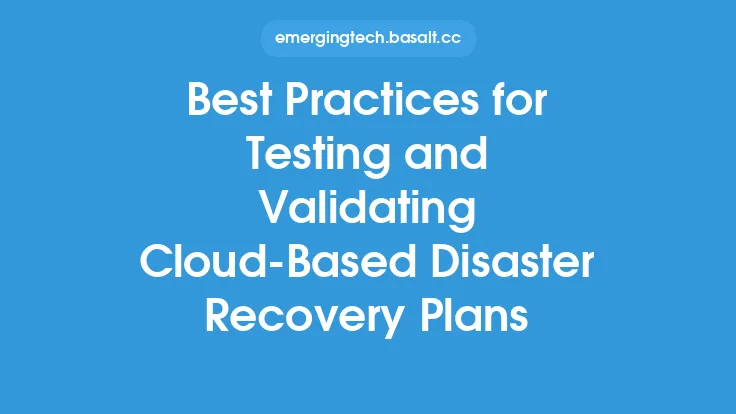In today's digital age, businesses are increasingly reliant on cloud computing to store, process, and manage their critical data and applications. However, with this increased reliance comes the risk of downtime, data loss, and other disasters that can have a significant impact on business operations and reputation. To mitigate these risks, it is essential for organizations to have a comprehensive cloud disaster recovery and business continuity plan in place. This plan should encompass a holistic approach that takes into account the entire organization, including its people, processes, and technology.
Introduction to Cloud Disaster Recovery
Cloud disaster recovery refers to the process of restoring cloud-based applications, data, and infrastructure in the event of a disaster or outage. This can include natural disasters, cyber-attacks, hardware failures, and other disruptions that can impact business operations. Cloud disaster recovery involves a range of strategies and technologies, including data backup and replication, virtualization, and cloud-based infrastructure. The goal of cloud disaster recovery is to minimize downtime, ensure business continuity, and prevent data loss.
Business Continuity Planning
Business continuity planning is a critical component of cloud disaster recovery. It involves identifying the organization's critical functions and processes, as well as the resources and infrastructure required to support them. Business continuity planning also involves developing strategies and procedures for responding to disasters and outages, including communication plans, emergency procedures, and training programs. The goal of business continuity planning is to ensure that the organization can continue to operate and deliver its products and services, even in the event of a disaster or outage.
Key Components of a Cloud Disaster Recovery Plan
A comprehensive cloud disaster recovery plan should include several key components, including:
- Data backup and replication: This involves creating copies of critical data and storing them in a secure, off-site location, such as a cloud storage service.
- Virtualization: This involves creating virtual machines and storage systems that can be easily replicated and restored in the event of a disaster.
- Cloud-based infrastructure: This involves using cloud-based infrastructure, such as virtual private clouds and cloud-based storage, to support critical applications and data.
- Disaster recovery as a service (DRaaS): This involves using a cloud-based disaster recovery service to provide automated backup, replication, and recovery of critical data and applications.
- Testing and validation: This involves regularly testing and validating the cloud disaster recovery plan to ensure that it is effective and can be executed quickly and efficiently.
Technical Considerations for Cloud Disaster Recovery
From a technical perspective, cloud disaster recovery involves several key considerations, including:
- Data consistency and integrity: This involves ensuring that data is consistent and intact, even in the event of a disaster or outage.
- Network and infrastructure resilience: This involves ensuring that the network and infrastructure are resilient and can withstand disasters and outages.
- Security and access control: This involves ensuring that data and applications are secure and can only be accessed by authorized personnel.
- Scalability and flexibility: This involves ensuring that the cloud disaster recovery plan can scale to meet the needs of the organization, even in the event of a large-scale disaster.
- Compliance and regulatory requirements: This involves ensuring that the cloud disaster recovery plan meets all relevant compliance and regulatory requirements, such as data protection and privacy laws.
Best Practices for Implementing Cloud Disaster Recovery
To implement a effective cloud disaster recovery plan, organizations should follow several best practices, including:
- Conducting regular risk assessments and business impact analyses to identify critical functions and processes.
- Developing a comprehensive cloud disaster recovery plan that takes into account the entire organization.
- Implementing automated backup, replication, and recovery processes to minimize downtime and data loss.
- Regularly testing and validating the cloud disaster recovery plan to ensure that it is effective and can be executed quickly and efficiently.
- Providing training and awareness programs for personnel to ensure that they understand their roles and responsibilities in the event of a disaster or outage.
- Continuously monitoring and reviewing the cloud disaster recovery plan to ensure that it remains effective and relevant.
Conclusion
In conclusion, cloud disaster recovery and business continuity planning are critical components of any organization's overall risk management strategy. By taking a holistic approach that encompasses people, processes, and technology, organizations can minimize downtime, ensure business continuity, and prevent data loss. By following best practices and considering technical requirements, organizations can implement a comprehensive cloud disaster recovery plan that meets their unique needs and requirements. Ultimately, a well-planned and well-executed cloud disaster recovery plan can help organizations to build resilience, ensure continuity, and achieve their strategic objectives, even in the face of disasters and outages.





